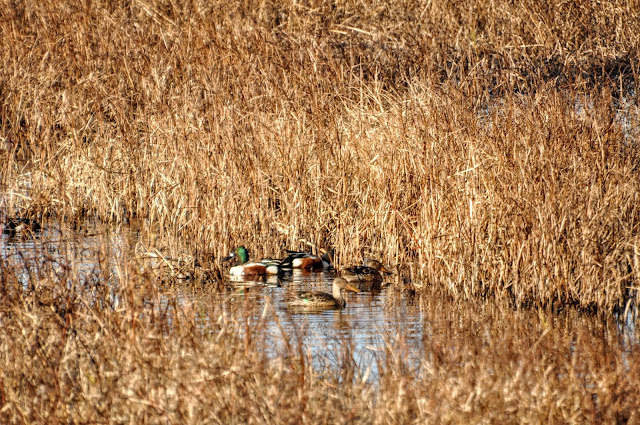I’ve been to the Blackwater National Wildlife Refuge (NWR) before, but never in November, when a lot of the waterfowl are there.
Of course there were heron, although not as many as you might see during the warmer months.
The best time to see waterfowl is November through February. The refuge serves as an important resting and feeding area for migrating and wintering waterfowl and is one of the chief wintering areas.
Wintering species includes tundra swans, snow geese, and more than 20 duck species, including the ubiquitous mallards, blue- and green-winged teals, wigeon, wood ducks, shovelers, mergansers, and pintails. Mallards and wood ducks can be found in the refuge all year long.
And there were mallards, and northern shovelers, which I mistook for mallards…
- March sees most of the migratory waterfowl depart for their northern summer homes, while masses of red-winged black birds will pass through (some remain). Osprey return from their wintering grounds and begin to build their nests. Eagle eggs begin to hatch.
- Osprey, wild turkey and northern bobwhite all begin to nest. Waterfowl incubate eggs and the majority of migrant marsh birds return by mid-April and blue-winged and green-winged teal pass through; peak shorebird migration occurs in late April – early May.
- Eagles start to fledge in May and the first broods of waterfowl appear.
- Ospreys begin to hatch in June; songbirds begin to nest; young waterfowl begin to fly in June. Large concentrations of flies and mosquitoes appear throughout the refuge, food for swallows, kingbirds and flycatchers.
- Ospreys fledge in July.
- Wading bird numbers increase in August as the blue-winged teal (the last to leave, the first to arrive) from the north in their southward migration for the winter.
- Ospreys leave in September to migrate to South and Central America, but the waterfowl numbers steadily increase. Egrets and herons also increase until the first cold weather pushes them south. Songbird migration peaks in September and early October.
- Autumn color peaks in October. Blackbirds, the last of the songbirds to migrate, peak in October.
- Tundra swan arrive in late November.
- Bald eagle numbers increase with the arrival of northern migrants; golden eagles are also often seen.
- The Wildlife Drive is a good option for those who are mobility impaired, as it offers the opportunity to see birds from or near your vehicle. Many of the wildlife viewing areas are wheelchair accessible.
- If you plan on hiking any of the trails, waterproof boots are recommended.
- Check the website below for planned closures for hunting.
Hours: Wildlife Drive is open during daylight hours; the visitor center is open Tuesday – Sunday, 10 a.m. – 4 p.m. except for Federal holidays (including Thanksgiving and Christmas)
Website: https://www.fws.gov/refuge/Blackwater/visit/directions.html
- Blackwater NWR Eagles
- Blackwater NWR (2014)
- Bombay Hook and again
- Eastern Neck — COMING SOON!
- Kakaying in Blackwater NWR
- Prime Hook NWR




















